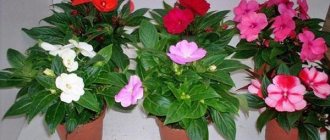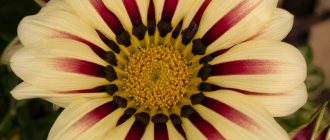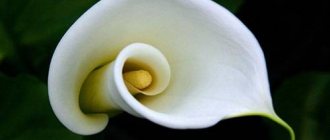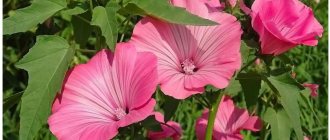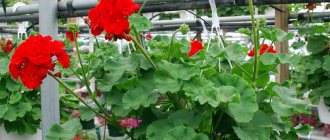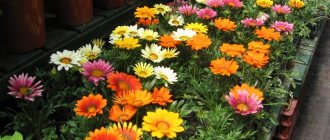Is it possible to sow Gatsania in open ground?
Gatsania
is a rather unpretentious plant, so it
can be
grown in
open ground
, on the balcony and in home pots. The only condition for this is maximum access to sunlight, moderate watering, and absence of drafts.
Interesting materials:
Which image format is better in quality? What image format does not lose quality? What is the book format for ebooks? Which format is better avi or mp4? Which format is best for a car radio? What format is needed for Photoshop? What format is needed for IGTV? What format is needed to burn a movie to DVD? What format does Samsung support? What format is Stories?
What annuals can you keep at home in winter?
Adding an article to a new collection
Many of the annuals we are accustomed to are perennial plants in their homeland. They simply cannot withstand our harsh winters and die with the onset of cold weather. But you can take the flowers home, provide them with care, and return them to the flowerbed in the spring!
In warm regions of the country, petunias, impatiens, and eustomas bloom for more than one year, but in the middle zone they are usually grown as annuals. It's a shame, because these and many other plants still have the strength to grow and bloom. To preserve flowers until spring and thereby save time and money on growing new specimens, there are several ways.
Digging up a bush. A rather traumatic method, when the plant is dug up, placed in a pot and kept in the house, and in the spring it is planted in a flowerbed. In addition, the bush can take up a lot of space indoors, and its decorative value will also be reduced.
Preservation of rhizomes. In this case, the entire above-ground part is removed, and the rhizome is stored in the cellar. This option is convenient, but not suitable for all colors.
Transfer in a container. If the plant grew in a container or hanging pot, you can simply move it into the house or winter garden. This is the easiest way to save flyers.
Cuttings. A reliable method, although it requires special skills. To take cuttings, select the strongest plants and then root them at home.
Garden plants brought into the house must be temporarily isolated from indoor flowers in order to reduce the risk of pests attacking the latter. If after a couple of weeks there are signs of aphids, spider mites, etc., treat the plants with a soap solution (4-5 tablespoons of laundry soap per 1 liter of water) or ready-made insecticides.
When storing heat-loving perennials at home, various problems may arise. The main ones: lack of lighting and dry warm air. Therefore, it is best to make sure in advance that you have a bright, cool room. Also note that watering garden plants in winter should be minimal, and fertilizing is unacceptable. You need to pick up bushes from the flower garden before frosts begin, when they are still strong and not withered. We will look in more detail at how to preserve annuals in winter using specific examples.
How to preserve bacopa at home in winter
Bacopa is a beautiful hanging plant that is capable of perennial flowering. But in the cold conditions of the middle zone, the flower inevitably freezes out in winter. To prevent this from happening, move the plant and container to a draft-free room with a temperature of 8-15°C. Water the flower moderately, spray occasionally.
Since by the end of winter the bacopa bush finally loses its decorative effect, it is advisable not to return it to the flowerbed, but to use it for cuttings. The procedure can be performed from January to March. Select the healthiest shoots, cut off their top with two nodes to a length of about 10 cm and plant in a moist, fertile substrate so that the bottom node is underground: a root will form from it. Place the container with the cuttings in a warm place and water it regularly. In early May, plant strong plants in flowerpots and containers.
How to propagate a plant using cuttings
Gatsania can also be propagated using cuttings. Mid-summer is precisely the period when gatsania, a perennial or annual, calmly reproduces with the help of cuttings obtained from side shoots at the base of the stems.
First, treat the cuttings with preparations that stimulate root formation, then plant them in the shade so that the sun's rays do not fall on them. They need to get used to the new place. When you see that the cuttings have taken root, take a lump of earth along with the cutting and plant it in the place you have chosen.
This is how gazania will always grow on your site. Now you already know how to preserve such a flower in winter.
The best varieties for growing by seedling method
Gazania gets along well with species of its family. This makes the work easier when planting and decorating flower beds. But before you start forming a future flower bed, you should carefully study the varietal varieties and the nuances of cultivation.
Long-rifle
Refers to the annual species of gatsaniya. Height: on average 20 cm and below. The leaf blades, which are slightly dissected near the root, are rich green. Pubescence only on the lower part of the leaf.
The inflorescence develops to a maximum of 7 cm. Color: rich yellow with a brown base.
Hard or shiny
Plant height: no more than 30 cm. The inflorescences are small (up to 6 cm in diameter), with tubular leaves. Color palette combination:
- tubular: purplish-black;
- reed: red, white, yellow, orange.
There are also flowers with spots (white, black, brown). The green part is standard, but the leaves are either entire or pinnately divided.
Peacock (Gazania pavonia)
The variety is more of a shrub. External description:
- stem: short;
- inflorescence: yellow color, diameter – 7-8 cm;
- reed petals: bright orange with a black spot.
Growing godetia from seeds
Godetia is grown from seeds, which are sown directly in the garden bed or seedlings are prepared to obtain earlier flowering.
If we sow in the ground
Godetia growing from seeds when to plant Photos of seedlings Godetia seedlings
Godetia seeds are not vulnerable to spring frosts, so you can sow them as soon as possible: the plants will sprout earlier and delight you with flowers at an earlier date. Sowing is carried out already at the beginning of April and until the very end of May. They also practice sowing before winter, in October.
- The bed is prepared in advance: the seeds are very small, it will be better if the soil settles.
- We fill the furrows every 10-12 cm, the depth is no more than 5-6 cm.
- We sow less often, so as not to suffer and break through later. When the seedlings grow up, they are planted in a permanent place.
In the flowerbed, godetia is planted every 20-30 cm to provide enough space for the development of beautiful bushes.
If it is not possible to plant seedlings, then the seeds are sown immediately at the place of growth in early April. It can be planted even before winter: with this method, it turns out to be even more hardened, blooming earlier. When the plants reach a height of 7 cm, they are thinned out, leaving an interval of 20 cm between the bushes.
Planting seeds for seedlings at home
You can sow as early as the twentieth of March in order to get beautiful seedling bushes by May.
- Seeds are sown in March in individual containers - after 10 days the first shoots appear.
- Godetia seedlings react painfully to transplantation. Therefore, to sow seeds in seedlings, it is advisable to purchase peat pots or tablets, placing 2-3 grains in each.
- Moderate watering is needed to prevent fungal diseases from developing.
- A lot of light is needed, at least 12 hours a day.
- At the beginning of May, we begin to accustom the plants to sunlight and wind by moving them outside. Starting from an hour or two, we increase the “baths” to a full day. And if the weather is warm, you can leave it overnight.
Plant ready seedlings in the ground in May, making sure that there will be no night frosts. You need to carefully pull out the plants with a lump of earth so as not to disturb its integrity, and place it vertically in a previously prepared hole. It’s good to put a couple of humus at the bottom of the hole. The hole is sprinkled with earth and watered until completely moistened. Make sure that the soil does not dry out during the first week. It is good if the tree trunk space is mulched with grass or any other organic matter.
The video will tell you about growing godetia seedlings at home:
Before planting in flower beds, seedlings are periodically watered, preventing the soil from drying out. Feed 2 times: 1st time - after emergence and 2nd time a week before planting with complete fertilizer. It should be noted that godetia does not tolerate transplantation well, and it is better to carry out all operations with seedlings without waiting for the plants to fill the entire earthen ball of the container.
If Godetia seedlings have stretched out
This means that it does not have enough lighting and is very densely sown. Exit: dive into separate containers, find a sunnier place for the seedlings, or provide additional illumination with lamps. And reduce watering to a minimum. 5-6 days after picking, you can feed with complex fertilizer for flowers, diluted to half the recommended concentration.
Godetia tolerates frost and has increased resistance to low temperatures. Compact, low-growing plants with a height of no more than 30 cm are most suitable for this. Even novice gardeners can care for godetia indoors. And she will repay your care with lush flowering of magnificent bright buds. Large-flowered varieties look especially impressive, which, hanging from the pot under their own weight, create a blooming cloud hovering over the windowsill.
Features of the plant
This interesting southern specimen has its own complex character. It manifests itself in the fact that if it is cloudy outside, the petals close and the middle of the flower becomes invisible.
Initially, these plants, accustomed to warmth and light, could bloom from sunrise to sunset, but in bad weather they remain closed. But flower growers would like more. And then, through trial and error, they began to experiment with how this plant responded to weather conditions. And now, thanks to their actions, a hybrid called Talent appeared.
As a result, you can now admire the colorful shades of the flower in any weather. So our specialists, despite the capricious mood of the plant, quickly found a way out of the situation.
African daisies love watering. It is advisable for them to arrange it systematically in the heat. If you do not do this on hot days, then the flowers will become smaller and smaller before your eyes. And, of course, they will no longer be able to delight us with their beautiful coloring.
How to care?
The first thing you need to do after transplanting is to decide on the wintering location of the flower. Most gardeners prefer to store gatsaniya on the balcony, but if the conditions are unsuitable, they bring it into the apartment. It is important to provide the plant with a large amount of sunlight, so it is recommended to place it on a windowsill with a sunny side. Artificial lighting is also added, since the optimal time to receive light is at least 8 hours a day.
An important aspect of gatsaniya care is maintaining optimal temperature. The flower loves temperatures from 20 degrees, but tolerates frosts down to -5, so a comfortable temperature for wintering is considered to be 8-11 degrees. Temperatures below threaten disease or death of the plant.
Water as needed (every couple of days). Excessive watering or drought will have a bad effect on the flower.
How to care
After two weeks of planting, feed the gatsaniya with mineral fertilizers. If the site has poor soil or flowers grow in a container, then use complex fertilizers, but also after some time, within 14 days.
Be sure to feed a plant such as gatsania at the beginning of the season. Cultivation and care, properly organized, are the actions that will help her constantly delight you with her flowering.
The most favorable soil for gatsaniya is sandy loam. It should not be over-moistened. And, importantly, it should contain a lot of humus. When the flowers gain strength, fertilizing can be canceled. Always remove faded inflorescences and flower stalks.
Possible difficulties and mistakes in care
Any self-respecting gardener can make mistakes when caring, since gatsaniya is considered a fragile plant. At the end of winter, some problems may appear:
- Lack of flowers. This is due to the incorrect content of the flower. There are several reasons - improper watering, insufficient sunlight or non-compliance with the temperature regime. To solve the problem, it is necessary to feed the plant with potassium and phosphorus. Nitrogen is fertilized in extreme cases.
- Damage to roots by gray rot. The only reason is overwatering the plant.
If, after all, the plant did not survive the winter, then it will have to be grown as seedlings from seeds. Gazania gets along with any plants without causing discomfort. There are a lot of flower varieties. A distinctive feature of some varieties is that when the sun sets, they fold their petals. The remaining views remain open all night.
Advice! To ensure that gatsania blooms quickly and lasts, it is recommended to cut off dried buds.
The most important thing in caring for gatsaniya is care and love. If the plant is provided with all the conditions, it will always delight with its beauty and aroma in the garden.
Gatsania is a bright flower, the structure of the bud is similar to a large chamomile. Otherwise, the flower is called gazania, named after Theodore Gaze, a priest and botanist from Italy. It came to us from South Africa, where even in winter it is warmer than +8°C.
In their homeland, these flowers are perennial, but how to preserve gatsaniya in winter in areas with periodic sub-zero temperatures has to be decided based on the available possibilities. If desired, this can be an ordinary apartment.
